Abstract
Rapid development of nanotechnology in recent years has raised concerns about nanoparticle (NPs) release into the environment and its adverse effects on living organisms. The present study is the first comprehensive report on the anatomical and ultrastructural changes of a variety of cells after long-term exposure of plant to NPs or bulk material particles (BPs). Light and electron microscopy revealed some anatomical and ultrastructural modifications of the different types of cell in the root and leaf, induced by both types of treatment. Zinc oxide (ZnO) BPs-induced modifications were surprisingly more than those induced by ZnO NPs. The modifications induced by ZnO BPs or ZnO NPs were almost similar to those induced by excess Zn. Zn content of the root and leaf of both ZnO NPs- and ZnO BPs-treated plants was severely increased, where the increase was greater in the plants treated with ZnO BPs. Overall, these results indicate that the modifications induced by ZnO particles can be attributed, at least partly, to the Zn2+ dissolution by ZnO particles rather than their absorption by root and their subsequent effects.







Similar content being viewed by others
References
Ali B, Qian P, Jin R, Ali S, Khan M, Aziz R, Tian T, Zhou W (2014) Physiological and ultra-structural changes in Brassica napus seedlings induced by cadmium stress. Biol Plant 58(1):131–138
Atha DH, Wang H, Petersen EJ, Cleveland D, Holbrook RD, Jaruga P, Dizdaroglu M, Xing B, Nelson BC (2012) Copper oxide nanoparticle mediated DNA damage in terrestrial plant models. Environ Sci Technol 46:1819–1827
Burbulis N, Kuprienė R, Blinstrubienė A (2008) Callus induction and plant regeneration from somatic tissue in spring rapeseed (Brassica napus L.). Biogeosciences 54(4):258–263
Chan A, Belmonte MF (2013) Histological and ultrastructural changes in canola (Brassica napus) funicular anatomy during the seed life cycle. Botany 91:671–679
Davies KL, Davies MS, Francis D (1991) Zinc-induced vacuolation in root meristematic cells of Festuca rubra L. Plant Cell Environ 14:399–406
Evert RF (2006) Esau’s plant anatomy. John Wiley & Sons, New Jersey
Ghodake GY, Seo D, Lee DS (2011) Hazardous phytotoxic nature of cobalt and Zn oxide nanoparticles assessed using Allium cepa. J Hazard Mater 186:952–955
Ghosh S, Mahoney SR, Penterman JN, Peirson D, Dumbroff EB (2001) Ultrastructural and biochemical changes in chloroplasts during Brassica napus senescence. Plant Physiol Biochem 39:777–784
Gill RA, Zang L, Ali B, Farooq MA, Cui P, Yang S, Ali S, Zhou W (2015) Chromium-induced physio-chemical and ultrastructural changes in four cultivars of Brassica napus L. Chemosphere 120:154–164
Hernandez-Viezcas JA, Castillo-Michel H, Servin AD, Peralta-Videa JR, Gardea-Torresdey JL (2011) Spectroscopic verification of Zn absorption and distribution in the desert plant Prosopis juliflora-velutina (velvet mesquite) treated with ZnO nanoparticles. Chem Eng J 170:346–352
Jiang HM, Yang JC, Zhang JF (2007) Effects of external phosphorus on the cell ultrastructure and the chlorophyll content of maize under cadmium and Zn stress. Environ Pollut 147:750–756
Jones N, Binata R, Koodali T, Adhar M (2007) Antibacterial activity of ZnO nanoparticle suspensions on a broad spectrum of microorganisms. FEMS Microbiol Lett 279:71–76
Kabata-Pendias A (2011) Trace elements in soils and plants. CRC press, Boca Raton
Kalra YP (1998) Handbook of methods for plant analysis. CRC Press, Boca Raton
Kumari M, Khan SS, Pakrashi S, Mukherjee A, Chandrasekaran N (2011) Cytogenetic and genotoxic effects of zinc oxide nanoparticles on root cells of Allium cepa. J Hazard Mater 190:613–621
Lee S, Chung H, Kim S, Lee I (2013a) The genotoxic effect of ZnO and CuO nanoparticles on early growth of buckwheat, Fagopyrum Esculentum. Water Air Soil Pollut 224:1668
Lee S, Kim S, Kim S, Lee I (2013b) Assessment of phytotoxicity of ZnO NPs on a medicinal plant, Fagopyrum esculentum. Environ Sci Pollut Res 20:848–854
Lin D, Xing B (2007) Phytotoxicity of nanoparticles: inhibition of seed germination and root growth. Environ Pollut 150:243–250
Lin D, Xing B (2008) Root uptake and phytotoxicity of ZnO nanoparticles. Environ Sci Technol 42:5580–5585
Ma X, Geiser-Lee J, Deng Y, Kolmakov A (2010) Interactions between engineered nanoparticles (ENPs) and plants: phytotoxicity, uptake and accumulation. Sci Total Environ 408:3053–3061
Marschner H (1995) Mineral nutrition of higher plants. Academic, London
Maruthi Sridhar BB, Diehl SV, Han FX, Monts DL, Su Y (2005) Anatomical changes due to uptake and accumulation of Zn and Cd in Indian mustard (Brassica juncea). Environ Exp Bot 54:131–141
Mousavi Kouhi SM, Lahouti M, Ganjeali A, Entezari MH (2014) Comparative phytotoxicity of ZnO nanoparticles, ZnO microparticles, and Zn2+ on rapeseed (Brassica napus L.): investigating a wide range of concentrations. Toxicol Environ Chem 96(6):861–868
Musgrave ME, Kuang A, Brown CS, Matthews SW (1998) Changes in arabidopsis leaf ultrastructure, chlorophyll and carbohydrate content during spaceflight depend on ventilation. Ann Bot 81:503–512
Ng CT, Li JJ, Bay BH, Yung LYL (2010) Current studies into the genotoxic effects of nanomaterials. J Nucleic Acids 2010:1–12
Peralta-Videa JR, Hernandez-Viezcas JA, Zhao L, Diaz BC, Ge Y, Priester JH, Holden PA, Gardea-Torresdey JL (2014) Cerium dioxide and Zn oxide nanoparticles alter the nutritional value of soil cultivated soybean plants. Plant Physiol Biochem 80:128–135
Pokhrel LR, Dubey B (2013) Evaluation of developmental responses of two crop plants exposed to silver and Zn oxide nanoparticles. Sci Total Environ 452–453:321–332
Priester JH, Ge Y, Mielke RE, Horst AM, Moritz SC, Espinosa K, Gelb J, Walker SL, Nisbet RM, An YJ, Schimel JP, Palmer RG, Hernandez-Viezcas JA, Zhao L, Gardea-Torresdey JL, Holden PA (2012) Soybean susceptibility to manufactured nanomaterials with evidence for food quality and soil fertility interruption. Proc Natl Acad Sci 109(37):14734–14735
Rao S, Shekhawat GS (2014) Toxicity of ZnO engineered nanoparticles and evaluation of their effect on growth, metabolism and tissue specific accumulation in Brassica juncea. J Environ Chem Eng 2:105–114
Remedios C, Rosario F, Bastos V (2012) Environmental nanoparticles interactions with plants: morphological, physiological, and genotoxic aspects. J Bot 2012:1–8
Rufner R, Barker AV (1984) Ultrastructure of Zn induced iron deficiency in mesophyll chloroplasts of spinach and tomato. J Am Soc Hortic Sci 109:164–168
Saeidnia S, Gohari AR (2012) Importance of Brassica napus as a medicinal food plant. J Med Plants Res 6(14):2700–2703
Sato T, Katakura T, Yin S, Fujimoto T, Yabe S (2004) Synthesis, UV-shielding properties of calcia-doped CeO2 nanoparticles coated with amorphous silica. Solid State Ion 172:377–382
Sresty TVS, Madhava Rao KV (1999) Ultrastructural alterations in response to Zn and nickel stress in the root cells of pigeonpea. Environ Exp Bot 41:3–13
Stampoulis D, Sinha SK, White JC (2009) Assay-dependent phytotoxicity of nanoparticles to plants. Environ Sci Technol 43:9473–9479
Stefanowska M, Kuras M, Kubacka-Zebalska M, Kacperska A (1999) Low temperature affects pattern of leaf growth and structure of cell walls in winter oilseed rape (Brassica napus L., var. oleifera L.). Ann Bot 84:313–319
Taiz L, Zeiger E (2010) Plant physiology. Sinauer Associates, Sunderland
Todeschini V, Lingua G, D’Agostino G, Carniato F, Roccotiello E, Berta G (2011) Effects of high Zn concentration on poplar leaves: a morphological and biochemical study. Environ Exp Bot 71:50–56
Xu H, Liu X, Cui D, Li M, Jiang M (2006) A novel method for improving the performance of ZnO gas sensors. Sens Actuators B Chem 114:301–307
Yoo J, Lee J, Kim S, Yoon K, Park J, Dhungel SK, Karunagaran B, Mangalaraj D, Yi J (2005) High transmittance and low resistive ZnO: Al films for thin film solar cells. Thin Solid Films 480:213–217
Yoon SJ, Kwak JI, Lee WM, Holden PA, An YJ (2014) Zn oxide nanoparticles delay soybean development: a standard soil microcosm study. Ecotoxicol Environ Saf 100:131–137
Zaier H, Ghnaya T, Ben Rejeb K, Lakhdar A, Rejeb S, Jemal F (2010) Effects of EDTA on phytoextraction of heavy metals (Zn, Mn and Pb) from sludge-amended soil with Brassica napus. Bioresour Technol 101:3978–3983
Zhao L, Peralta-Videa JR, Ren M, Varela-Ramirez A, Li C, Hernandez-Viezcas JA, Aguilera RJ, Gardea-Torresdey JL (2012) Transport of Zn in a sandy loam soil treated with ZnO NPs and uptake by corn plants: Electron microprobe and confocal microscopy studies. Chem Eng J 184:1–8
Acknowledgments
This work was supported by the Faculty of Sciences, Ferdowsi University of Mashhad, Iran, under Grant Number 24427. The authors thank Dr. Azizi for procuring the standard seeds of B. napus. The authors are grateful to Mrs Fatemeh Naseri and Mrs Roksana Pesian for preparing the samples for TEM and taking TEM micrographs, respectively.
Conflict of interest
The authors declare that they have no conflict of interest.
Author information
Authors and Affiliations
Corresponding author
Additional information
Responsible editor: Elena Maestri
Rights and permissions
About this article
Cite this article
Mousavi Kouhi, S.M., Lahouti, M., Ganjeali, A. et al. Long-term exposure of rapeseed (Brassica napus L.) to ZnO nanoparticles: anatomical and ultrastructural responses. Environ Sci Pollut Res 22, 10733–10743 (2015). https://doi.org/10.1007/s11356-015-4306-0
Received:
Accepted:
Published:
Issue Date:
DOI: https://doi.org/10.1007/s11356-015-4306-0




